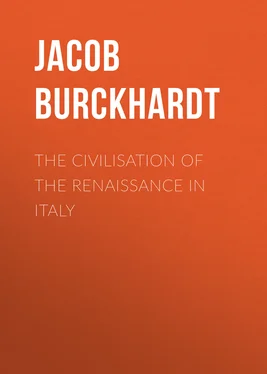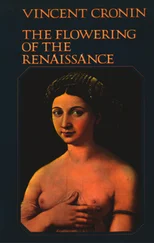Jacob Burckhardt - The Civilisation of the Renaissance in Italy
Здесь есть возможность читать онлайн «Jacob Burckhardt - The Civilisation of the Renaissance in Italy» — ознакомительный отрывок электронной книги совершенно бесплатно, а после прочтения отрывка купить полную версию. В некоторых случаях можно слушать аудио, скачать через торрент в формате fb2 и присутствует краткое содержание. Жанр: foreign_prose, История, foreign_edu, foreign_antique, на английском языке. Описание произведения, (предисловие) а так же отзывы посетителей доступны на портале библиотеки ЛибКат.
- Название:The Civilisation of the Renaissance in Italy
- Автор:
- Жанр:
- Год:неизвестен
- ISBN:нет данных
- Рейтинг книги:5 / 5. Голосов: 1
-
Избранное:Добавить в избранное
- Отзывы:
-
Ваша оценка:
- 100
- 1
- 2
- 3
- 4
- 5
The Civilisation of the Renaissance in Italy: краткое содержание, описание и аннотация
Предлагаем к чтению аннотацию, описание, краткое содержание или предисловие (зависит от того, что написал сам автор книги «The Civilisation of the Renaissance in Italy»). Если вы не нашли необходимую информацию о книге — напишите в комментариях, мы постараемся отыскать её.
The Civilisation of the Renaissance in Italy — читать онлайн ознакомительный отрывок
Ниже представлен текст книги, разбитый по страницам. Система сохранения места последней прочитанной страницы, позволяет с удобством читать онлайн бесплатно книгу «The Civilisation of the Renaissance in Italy», без необходимости каждый раз заново искать на чём Вы остановились. Поставьте закладку, и сможете в любой момент перейти на страницу, на которой закончили чтение.
Интервал:
Закладка:
135
Chron. Ven. l. c. col. 166.
136
Malipiero, l. c. vii. i. 349. For other lists of the same kind see Marin Sanudo, Vite dei Duchi , Murat. xxii. col. 990 (year 1426), col. 1088 (year 1440), in Corio, fol. 435-438 (1483), in Guazzo Historie , fol. 151 sqq.
137
Guicciardini ( Ricordi , n. 150) is one of the first to remark that the passion for vengeance can drown the clearest voice of self-interest.
138
Malipiero, l. c. vii. i., p. 328.
139
The statistical view of Milan, in the ‘Manipulus Florum’ (in Murat. xi. 711 sqq.) for the year 1288, is important, though not extensive. It includes house-doors, population, men of military age, ‘loggie’ of the nobles, wells, bakeries, wine-shops, butchers’-shops, fishmongers, the consumption of corn, dogs, birds of chase, the price of salt, wood, hay, and wines; also the judges, notaries, doctors, schoolmasters, copying clerks, armourers, smiths, hospitals, monasteries, endowments, and religious corporations. A list perhaps still older is found in the ‘Liber de magnalibus Mediolani,’ in Heinr. de Hervordia , ed. Potthast, p. 165. See also the statistical account of Asti about the year 1250 in Ogerius Alpherius (Alfieri), De Gestis Astensium, Histor. patr. Monumenta, Scriptorum , tom. iii. col. 684. sqq.
140
Especially Marin Sanudo, in the Vite dei Duchi di Venezia , Murat. xxii. passim .
141
See for the marked difference between Venice and Florence, an important pamphlet addressed 1472 to Lorenzo de’ Medici by certain Venetians, and the answer to it by Benedetto Dei, in Paganini, Della Decima , Florence, 1763, iii. pp. 135 sqq.
142
In Sanudo, l. c. col. 958. What relates to trade is extracted in Scherer, Allgem. Gesch. des Welthandels , i. 326, note.
143
Here all the houses, not merely those owned by the state, are meant. The latter, however, sometimes yielded enormous rents. See Vasari, xiii. 83. V. d. Jac. Sansovino.
144
See Sanudo, col. 963. In the same place a list of the incomes of the other Italian and European powers is given. An estimate for 1490 is to be found, col. 1245 sqq.
145
This dislike seems to have amounted to positive hatred in Paul II. who called the humanists one and all heretics. Platina, Vita Pauli , ii. p. 323. See also for the subject in general, Voigt, Wiederbelebung des classischen Alterthums , Berlin, 1859, pp. 207-213. The neglect of the sciences is given as a reason for the flourishing condition of Venice by Lil. Greg. Giraldus, Opera , ii. p. 439.
146
Sanudo, l. c. col. 1167.
147
Sansovina, Venezia , lib. xiii. It contains the biographies of the Doges in chronological order, and, following these lives one by one (regularly from the year 1312, under the heading Scrittori Veneti ), short notices of contemporary writers.
148
Venice was then one of the chief seats of the Petrarchists. See G. Crespan, Del Petrarchismo , in Petrarca e Venezia , 1874, pp. 187-253.
149
See Heinric. de Hervordia ad a. 1293, p. 213, ed. Potthast, who says: ‘The Venetians wished to obtain the body of Jacob of Forli from the inhabitants of that place, as many miracles were wrought by it. They promised many things in return, among others to bear all the expense of canonising the defunct, but without obtaining their request.’
150
Sanudo, l. c. col. 1158, 1171, 1177. When the body of St. Luke was brought from Bosnia, a dispute arose with the Benedictines of S. Giustina at Padua, who claimed to possess it already, and the Pope had to decide between the two parties. Comp. Guicciardini, Ricordi , n. 401.
151
Sansovino, Venezia , lib. xii. ‘dell’andate publiche del principe.’ Egnatius, fol. 50 a . For the dread felt at the papal interdict see Egnatius, fol. 12 a sqq.
152
G. Villani, viii. 36. The year 1300 is also a fixed date in the Divine Comedy .
153
Stated about 1470 in Vespas. Fiorent. p. 554.
154
The passage which followed in former editions referring to the Chronicle of Dino Compagni is here omitted, since the genuineness of the Chronicle has been disproved by Paul Scheffer-Boichhorst ( Florentiner Studien , Leipzig, 1874, pp. 45-210), and the disproof maintained ( Die Chronik des D. C. , Leipzig, 1875) against a distinguished authority (C. Hegel, Die Chronik des D. C., Versuch einer Rettung , Leipzig, 1875). Scheffer’s view is generally received in Germany (see W. Bernhardi, Der Stand der Dino-Frage, Hist. Zeitschr. N.F. , 1877, bd. i.), and even Hegel assumes that the text as we have it is a later manipulation of an unfinished work of Dino. Even in Italy, though the majority of scholars have wished to ignore this critical onslaught, as they have done other earlier ones of the same kind, some voices have been raised to recognise the spuriousness of the document. (See especially P. Fanfani in his periodical Il Borghini , and in the book Dino Campagni Vendicato , Milano, 1875). On the earliest Florentine histories in general see Hartwig, Forschungen , Marburg, 1876, and C. Hegel in H. von Sybel’s Historischer Zeitschrift , b. xxxv. Since then Isidore del Lungo, who with remarkable decision asserts its genuineness, has completed his great edition of Dino, and furnished it with a detailed introduction: Dino Campagni e la sua cronaca , 2 vols. Firenze, 1879-80. A manuscript of the history, dating back to the beginning of the fifteenth century, and consequently earlier than all the hitherto known references and editions, has been lately found. In consequence of the discovery of this MS. and of the researches undertaken by C. Hegel, and especially of the evidence that the style of the work does not differ from that of the fourteenth century, the prevailing view of the subject is essentially this, that the Chronicle contains an important kernel, which is genuine, which, however, perhaps even in the fourteenth century, was remodelled on the ground-plan of Villani’s Chronicle. Comp. Gaspary, Geschichte der italienischen Literatur . Berlin, 1885, i. pp. 361-9, 531 sqq.
155
Purgatorio , vi. at the end.
156
De Monarchia , i. 1. (New critical edition by Witte, Halle, 1863, 71; German translation by O. Hubatsch, Berlin, 1872).
157
Dantis Alligherii Epistolæ , cum notis C. Witte, Padua, 1827. He wished to keep the Pope as well as the Emperor always in Italy. See his letter, p. 35, during the conclave of Carpentras, 1314. On the first letter see Vitæ Nuova , cap. 31, and Epist. p. 9.
158
Giov. Villani, xi. 20. Comp. Matt. Villani, ix. 93, who says that John XXII. ‘astuto in tutte sue cose e massime in fare il danaio,’ left behind him 18 million florins in cash and 6 millions in jewels.
159
See for this and similar facts Giov. Villani, xi. 87, xii. 54. He lost his own money in the crash and was imprisoned for debt. See also Kervyn de Lettenhove, L’Europe au Siècle de Philippe le Bel, Les Argentiers Florentins in Bulletin de l’Académie de Bruxelles (1861), vol. xii. pp. 123 sqq.
Читать дальшеИнтервал:
Закладка:
Похожие книги на «The Civilisation of the Renaissance in Italy»
Представляем Вашему вниманию похожие книги на «The Civilisation of the Renaissance in Italy» списком для выбора. Мы отобрали схожую по названию и смыслу литературу в надежде предоставить читателям больше вариантов отыскать новые, интересные, ещё непрочитанные произведения.
Обсуждение, отзывы о книге «The Civilisation of the Renaissance in Italy» и просто собственные мнения читателей. Оставьте ваши комментарии, напишите, что Вы думаете о произведении, его смысле или главных героях. Укажите что конкретно понравилось, а что нет, и почему Вы так считаете.












